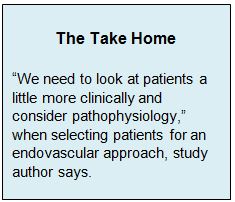Key Points:
- Researchers study link between baseline factors, outcomes of intracranial stenting
- Lesion characteristics, hypoprofusion more predictive than baseline stenosis
Identifying intracranial atherosclerotic lesion type using symptom status and stability may be a more useful way of selecting patients for endovascular therapy than degree of stenosis, according to an analysis published online November 21, 2014, ahead of print in the Journal of NeuroInterventional Surgery.
A team led by Matthew D. Alexander, MD, of the University of Washington (Seattle, WA), reviewed data from prospectively maintained treatment logs for 130 lesions present in 124 patients. They classified lesions based on symptom type as hypoperfusion (if medical records indicated clear evidence that reduced perfusion elicited ischemic symptoms), non-hypoperfusion (symptoms not clearly related to reduced perfusion), or indeterminate. In addition, lesions that were asymptomatic for ≥ 14 days were considered stable.
Percent stenosis was calculated and compared against the other lesion characteristics for its ability to predict technical complication, ischemic stroke, disability, or death at 90 days and 2 years.
Stenosis ranging from 60% to 99% was associated with a greater risk of technical complications but did not appear to affect other outcomes. Univariate analysis revealed a lower risk for stroke at 2 years in patients treated for lesions with symptoms arising from hypoperfusion and those that were stable. On multivariate analysis, only hypoperfusion remained significantly linked to reduced stroke risk at 2 years.
Natural History of Disease Could Inform Management
Evidence on the results of intracranial stenting has been mixed, Dr. Alexander told WLNCMD in a telephone interview. “SAMMPRIS was a pretty surprising trial given that there were such poor outcomes in the endovascular treatment arm,” he said. Other trials, including the NIH Wingspan stent registry trial and a retrospective analysis of cases conducted at the University of California, had yielded better results for endovascular therapy. “We wanted to know what might be accounting for the differences,” he explained.
Vessel-wall imaging of atherosclerotic lesions, both those that occur intracranially and those seen elsewhere in the body, has demonstrated that early disease may not be visible on angiography. Early disease may be the most active and likely to cause symptoms, said Dr. Alexander. Nevertheless, in SAMMPRIS, the decision to treat was driven only by the degree of vessel stenosis.
“The take home from SAMMPRIS is that medical management is the first choice for intracranial atherosclerosis and is better than we thought it was,” he said, “but some patients will continue to have symptoms on best medical therapy, indicating that there is still a role for endovascular therapy. The question is now to do more safely.”
According to Dr. Alexander, the current findings suggest that the answer might lie in careful clinical evaluation of patients, which can help determine the type of intracranial lesion present. Hypotension or positional symptoms are an indication of hypoperfusion, which this study identifies as a sign of good candidates for an endovascular intervention. Stroke and TIA, on the other hand, are signs of an active lesion that might be more risky to treat endovascularly.
In addition, the longer patients remain symptom-free following the symptom onset, the more likely their lesion is to be stable and safer to manage using endovascular therapy, he explained.
“We need to look at patients a little more clinically and consider pathophysiology,” he said. “Eventually, there might be role for vessel-wall imaging or biomarkers such as markers of inflammation.” Learning more about the natural history of intracranial atherosclerosis is the key to understanding how best to approach management in the future, he added.
Source:
Alexander MD, Cooke DL, Meyers PM, et al. Lesion stability characteristics outperform degree of stenosis in predicting outcomes following stenting for symptomatic intracranial atherosclerosis. J Neurointerv Surg. 2016;Epub ahead of print.
Disclosure:
- Dr. Alexander reports no relevant conflicts of interest.


